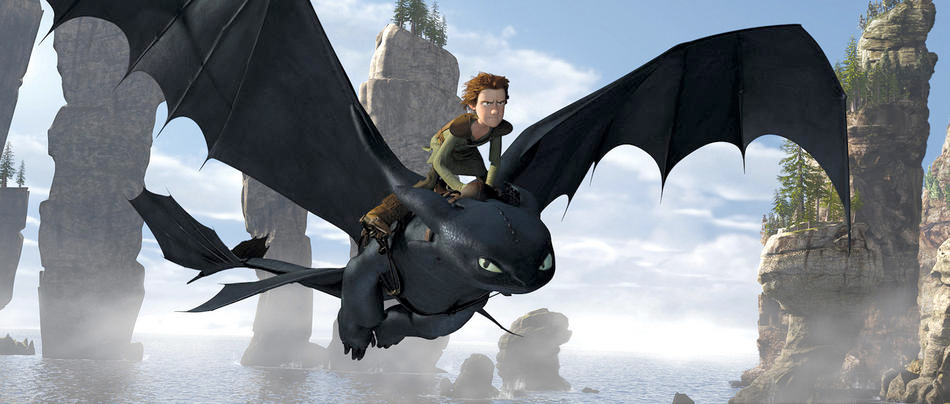Despite the outlandish success of the “Shrek” movies, there’s often a sad, also-ran vibe to DreamWorks’ animated movies. “A Shark’s Tale,” “Bee Movie,” Monsters vs. Aliens”: These movies aren’t terrible, and they’re probably reasonably enjoyable for kids. But they’re also, as the English would say, just a little too keen. With their pop-culture references stacked sky-high, their too-cute yet not cute enough characters, they’re tap-dancing as hard as they can to dazzle us with their wit and sophistication, as if to distract us from noticing that they’re so low on charm.
With “How to Train Your Dragon” — which was directed by Dean DeBlois and Chris Sanders and adapted from the book by Cressida Cowell — DreamWorks has managed to loosen the screws, at least a little. The writers — a team including DeBlois, Adam F. Goldberg, Chris Sanders, Peter Tolan — have focused more on the story than on loading it with hyper gags, and as a result the movie is both more relaxed and more focused than, for instance, DreamWorks Animation’s last picture, the cluttered and scattershot “Monsters vs. Aliens.” Hiccup (the voice of Jay Baruchel) is a brainy young Viking lad, living in a Viking village that must always be on the lookout for dangerous dragons. Hiccup’s father, the burly, bushy-bearded Stoick the Vast (Gerard Butler), is a brave dragon hunter, and the expectation is that Hiccup will follow in his footsteps. But Hiccup isn’t very good at slaying dragons. And when, one day, he encounters a wounded beastie who’s easy prey, he just can’t bring himself to do the deed. This is a good thing, because the young dragon — whom he names Toothless — becomes a loyal companion who teaches Hiccup that dragons aren’t to be feared and conquered but understood: There are benefits to sharing the world with them, instead of trying to wipe them from the face of the earth.
The picture has a tidy moral, for those who look for such things. It shows, gently enough, that received wisdom should always be questioned, and creatures (or, by extension, people) we might think of as foreign and scary are really much like us. “Everything we know about you guys is wrong,” Hiccup marvels as he comes to learn that Toothless has some very generous food-sharing impulses (he regurgitates a half-eaten fish and nudges it in Hiccup’s direction) and will fall asleep instantly if he’s scratched in a certain way.
“I looked at him, and I saw myself,” Hiccup says of Toothless in a particularly revelatory moment, though I’d hesitate to put too strict a geopolitical reading on “How to Train Your Dragon”: The formerly misunderstood dragons end up as Viking pets — beloved ones, but pets just the same. Beyond its easy-on-the-psyche message, the picture is reasonably pretty to look at. It was designed to be seen in 3-D, which means we often see Hiccup on Toothless’ back, swooping through the air above cloud-laced mountains and through artfully chiseled valleys. In one striking scene the two find themselves part of an air-traffic clog of fellow dragons of all shapes, sizes and varieties, all on their way to a mysterious somewhere.
“How to Train Your Dragon” is low on belabored gags, which makes sitting through it relatively painless (although you’ll have to suspend disbelief enough to reconcile all those Scottish accents tumbling out of Viking mouths — in addition to Butler’s voice, we also hear Craig Ferguson’s). The movie also has a strange, grim twist at the end that’s treated a little too blithely. And it reaffirms a recurring DreamWorks weakness: With one exception, the character design is uninspired. When you’ve seen one scrappy little Viking ragamuffin with a bulbous nose and half-moon smile, you’ve seen them all.
But then there’s Toothless: He may be a dragon, but with his rounded paws and panther-shaped head, there’s also something of the house cat in him — he has the same proportions of civilized dignity and wildness, as well as a tendency to express his affection in offhanded ways. (Remember that regurgitated fish?) Toothless has black Naugahyde skin that makes you want to reach out and touch it; his glowing green eyes are mischievous and appraising but not wholly unfriendly. And he doesn’t speak, which means that Hiccup — and we — must read his expression, the tilt of his ears, the way he swishes his tail, to know what he’s thinking, and even then we can’t be 100 percent sure. Toothless has the one precious ingredient that’s missing from so many of Hollywood’s contemporary animated characters: an air of mystery. For once, instead of spelling everything out for us with constant chatter, DreamWorks has gotten the knack of leaving something unsaid.

